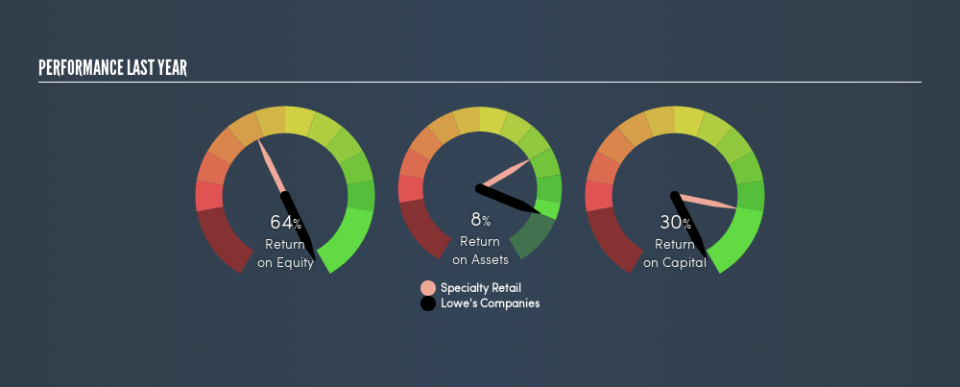Lowe's Companies, Inc. (NYSE:LOW) Earns Among The Best Returns In Its Industry

Today we'll evaluate Lowe's Companies, Inc. (NYSE:LOW) to determine whether it could have potential as an investment idea. Specifically, we're going to calculate its Return On Capital Employed (ROCE), in the hopes of getting some insight into the business.
Firstly, we'll go over how we calculate ROCE. Next, we'll compare it to others in its industry. Finally, we'll look at how its current liabilities affect its ROCE.
Understanding Return On Capital Employed (ROCE)
ROCE is a metric for evaluating how much pre-tax income (in percentage terms) a company earns on the capital invested in its business. All else being equal, a better business will have a higher ROCE. Overall, it is a valuable metric that has its flaws. Renowned investment researcher Michael Mauboussin has suggested that a high ROCE can indicate that 'one dollar invested in the company generates value of more than one dollar'.
How Do You Calculate Return On Capital Employed?
Analysts use this formula to calculate return on capital employed:
Return on Capital Employed = Earnings Before Interest and Tax (EBIT) ÷ (Total Assets - Current Liabilities)
Or for Lowe's Companies:
0.30 = US$6.1b ÷ (US$35b - US$14b) (Based on the trailing twelve months to February 2019.)
So, Lowe's Companies has an ROCE of 30%.
Want to participate in a short research study? Help shape the future of investing tools and you could win a $250 gift card!
View our latest analysis for Lowe's Companies
Does Lowe's Companies Have A Good ROCE?
One way to assess ROCE is to compare similar companies. In our analysis, Lowe's Companies's ROCE is meaningfully higher than the 13% average in the Specialty Retail industry. We consider this a positive sign, because it suggests it uses capital more efficiently than similar companies. Putting aside its position relative to its industry for now, in absolute terms, Lowe's Companies's ROCE is currently very good.
Our data shows that Lowe's Companies currently has an ROCE of 30%, compared to its ROCE of 24% 3 years ago. This makes us think about whether the company has been reinvesting shrewdly.
When considering this metric, keep in mind that it is backwards looking, and not necessarily predictive. Companies in cyclical industries can be difficult to understand using ROCE, as returns typically look high during boom times, and low during busts. ROCE is, after all, simply a snap shot of a single year. Since the future is so important for investors, you should check out our free report on analyst forecasts for Lowe's Companies.
Lowe's Companies's Current Liabilities And Their Impact On Its ROCE
Short term (or current) liabilities, are things like supplier invoices, overdrafts, or tax bills that need to be paid within 12 months. The ROCE equation subtracts current liabilities from capital employed, so a company with a lot of current liabilities appears to have less capital employed, and a higher ROCE than otherwise. To check the impact of this, we calculate if a company has high current liabilities relative to its total assets.
Lowe's Companies has total liabilities of US$14b and total assets of US$35b. As a result, its current liabilities are equal to approximately 42% of its total assets. Lowe's Companies's ROCE is boosted somewhat by its middling amount of current liabilities.
Our Take On Lowe's Companies's ROCE
Even so, it has a great ROCE, and could be an attractive prospect for further research. There might be better investments than Lowe's Companies out there, but you will have to work hard to find them . These promising businesses with rapidly growing earnings might be right up your alley.
For those who like to find winning investments this free list of growing companies with recent insider purchasing, could be just the ticket.
We aim to bring you long-term focused research analysis driven by fundamental data. Note that our analysis may not factor in the latest price-sensitive company announcements or qualitative material.
If you spot an error that warrants correction, please contact the editor at editorial-team@simplywallst.com. This article by Simply Wall St is general in nature. It does not constitute a recommendation to buy or sell any stock, and does not take account of your objectives, or your financial situation. Simply Wall St has no position in the stocks mentioned. Thank you for reading.

 Yahoo Movies
Yahoo Movies 

